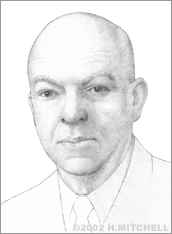Edwin Armstrong
Edwin Howard Armstrong, the "father of FM radio," was born on December 18, 1890 in New York City. He grew up in Yonkers, New York and knew by the age of fourteen that he wanted to become an inventor. He began tinkering with homemade wireless gadgets as a teenager, and as a high school student, he built an antenna mast on his family's front lawn to study wireless technology. He quickly identified a problem: there was no device in existence that could amplify weak signals at the receiving end of a communications transmission, nor was there a way to provide stronger power at the sending end. After he finished high school, he entered Columbia University's School of Engineering where he pursued his wireless studies further.
During his third year at Columbia, Armstrong came up with his first major invention: the first radio amplifier. He had learned how Lee DeForest's radio tube worked; then he redesigned it by taking the electromagnetic waves that came from a radio transmission and repeatedly feeding the signal back through the tube. Each time, the signal's power would increase as much as 20,000 times a second. This phenomenon, which Armstrong called "regeneration," was an extremely important discovery in the early days of radio. With this development, radio engineers no longer needed 20-ton generators to get their stations on the air. Armstrong's single-circuit design provided the key to the continuous-wave transmitter that is at the core of radio operations today. He graduated with his bachelor's degree in Engineering in 1913. He patented his creation and licensed it to the Marconi Corporation in 1914.
Soon after graduation, Armstrong was sent to Paris to serve in World War I. There, he came up with his second major invention, the superheterodyne receiver, after he had been put on a project to improve ability to intercept shortwave enemy communications. The superheterodyne receiver is still part of virtually every tuner in today's radios, televisions, and radars. In 1920, Westinghouse bought Armstrong's patent for the superheterodyne receiver and started up the nation's first radio station, KDKA, in Pittsburgh. Radio became very popular at about this time, and more and more stations came to the airwaves. The Radio Corporation of America, or RCA, soon bought up all of Westinghouse's radio patents, as well as the patents of other competitors.
By then, Armstrong was back at Columbia University working as a professor. In 1923, he married Marion MacInnes, secretary to the president of RCA, David Sarnoff. Later that decade, he became embroiled in a corporate war for control of radio patents. This continued through the early part of the 1930s, and Armstrong was unsuccessful in most of his court battles. Meanwhile, however, he pursued a solution to the problem of static in radio. By the late 1920s, he had decided the only solution was to design an entirely new system. In 1933, he presented the wide-band frequency modulation (FM) system, which gave clear reception even in storms and offered the highest fidelity sound yet heard in radio. The system also allowed for a single carrier wave to transmit two radio programs at once. This development was called "multiplexing." In 1940, Armstrong got a permit for the first FM station, which he established in Alpine, New Jersey.
In 1941, the Franklin Institute awarded Armstrong the Franklin Medal, one of the science community's highest honors. However, Armstrong, having unsuccessfully battled giant corporations for years who were profiting from his patents, committed suicide in 1954. His widow continued to fight Armstrong's legal battles, and she won millions of dollars in damages over the next several years. By the late 1960's, FM was established as the superior radio system, and is even used in earth-to-space communication.


